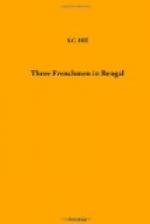As regards the European population at the time of the siege we have no definite information. The Returns drawn up by the French officials at the time of the capitulation do not include the women and children or the native and mixed population. The ladies,[15] and it is to be presumed the other women also, for there is no mention of women during the siege, retired to the Dutch and Danish settlements at Chinsurah and Serampore a few days before, and the native population disappeared as soon as the British army approached. The Returns therefore show only 538 Europeans and 66 Topasses. The Governor or Director, as already mentioned, was Pierre Renault: his Council consisted of MM. Fournier, Caillot, Laporterie, Nicolas, and Picques. There were 36 Frenchmen of lesser rank in the Company’s service, as well as 6 surgeons. The troops were commanded by M. de Tury and 10 officers. There were also 10 officers of the French East India Company’s vessels, and 107 persons of sufficient importance for their parole to be demanded when the Fort fell. Apparently these Returns do not include those who were killed in the defence, nor have we any definite information as to the number of French sepoys, but Eyre Coote[16] says there were 500.
The story of the siege is to be gathered from many accounts. M. Renault and his Council submitted an official report; Renault wrote many letters to Dupleix and other patrons or friends; several of the Council and other private persons did the same.[17] M. Jean Law, whose personal experiences we shall deal with in the next chapter, was Chief of Cossimbazar, and watched the siege, as it were, from the outside.




